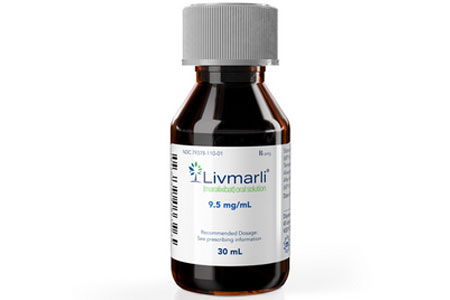Mirum Pharmaceuticals, Inc. announced that the U.S. Food and Drug Administration (FDA) has approved LIVMARLI® (maralixibat) oral solution for the treatment of cholestatic pruritus in patients five years of age and older with progressive familial intrahepatic cholestasis (PFIC).
Mirum has also submitted an additional supplemental new drug application (sNDA) to introduce a higher concentration formulation of LIVMARLI, used during the MARCH study, to enable label expansion for younger patients with PFIC, later this year.
LIVMARLI is also approved for the treatment of cholestatic pruritus in patients with Alagille syndrome (ALGS) in the U.S. (three months and older), Europe (two months and older), in Canada and other regions globally.
“LIVMARLI has the potential to have a transformational impact for patients with cholestatic pruritus associated with PFIC, and importantly, offers an option for those patients with the rarest of subtypes,” said Chris Peetz, chief executive officer at Mirum. “Thank you to the patients, families, and clinicians whose study participation made this approval possible.”
The approval is based on data from the Phase 3 MARCH study, the largest randomized trial conducted in PFIC, with 93 patients across a range of genetic PFIC types, including PFIC1, PFIC2, PFIC3, PFIC4, PFIC6, and unidentified mutational status.
“LIVMARLI’s approval in cholestatic pruritus for patients with PFIC is a result of years of investigation and a collection of a strong body of clinical evidence showing meaningful improvements across a number of important parameters, including pruritus, affecting children with PFIC,” said Richard Thompson, professor of molecular hepatology at King’s College London and an investigator in the MARCH study. “I am pleased that we will have a well-studied and efficacious option to offer patients whose life has been disrupted by itch.”
“PFIC is a difficult disease for both the patient and family and significantly impedes the quality of life for all,” said Emily Ventura, executive director of the PFIC Network and mom to a daughter with PFIC. “These young and fragile patients endure an itch so severe that they experience deficits in their sleep, nutrition, growth, and, in the past, some have turned to transplant to resolve their itch. We are hopeful that LIVMARLI will have a measurable impact for patients, potentially offering a new normal and relief from the sleepless nights and disruption to their lives caused by cholestatic pruritus.”
About PFIC
Progressive familial intrahepatic cholestasis (PFIC) is a rare genetic disorder that causes progressive liver disease typically leading to liver failure. In people with PFIC, liver cells are less able to secrete bile. The resulting buildup of bile causes liver disease in affected individuals. Signs and symptoms of PFIC typically begin in infancy. Patients experience severe itching, jaundice, failure to grow at the expected rate (failure to thrive), and an increasing inability of the liver to function (liver failure). The disease is estimated to affect one in every 50,000 to 100,000 births in the United States and Europe. More than six types of PFIC have been genetically identified, all of which are similarly characterized by impaired bile flow and progressive liver disease.
About LIVMARLI® (maralixibat) oral solution
LIVMARLI® (maralixibat) oral solution is an orally administered, once-daily, ileal bile acid transporter (IBAT) inhibitor and the only approved medication by the U.S. Food and Drug Administration for the treatment of cholestatic pruritus in patients with Alagille syndrome (ALGS) three months of age and older and progressive familial intrahepatic cholestasis (PFIC) five years of age and older.
LIVMARLI is also the only approved IBAT inhibitor approved by the European Commission for the treatment of cholestatic pruritus in patients with ALGS two months and older, and by Health Canada for the treatment of cholestatic pruritus in ALGS. For more information for U.S. residents, please visit LIVMARLI.com.
Mirum has also submitted LIVMARLI for approval in Europe in PFIC for patients two months of age and older.
LIVMARLI has received Breakthrough Therapy designation for ALGS and PFIC type 2 and orphan designation for ALGS and PFIC. To learn more about ongoing clinical trials with LIVMARLI, please visit Mirum’s clinical trials section on the company’s website.
IMPORTANT SAFETY INFORMATION
Limitation of Use: LIVMARLI is not for use in PFIC type 2 patients who have a severe defect in the bile salt export pump (BSEP) protein.
LIVMARLI can cause side effects, including:
Liver injury. Changes in certain liver tests are common in patients with Alagille syndrome and PFIC but can worsen during treatment. These changes may be a sign of liver injury. In PFIC, this can be serious or may lead to liver transplant or death. Your healthcare provider should do blood tests and physical exams before starting and during treatment to check your liver function. Tell your healthcare provider right away if you get any signs or symptoms of liver problems, including nausea or vomiting, skin or the white part of the eye turns yellow, dark or brown urine, pain on the right side of the stomach (abdomen), bloating in your stomach area, loss of appetite or bleeding or bruising more easily than normal.
Stomach and intestinal (gastrointestinal) problems. LIVMARLI can cause stomach and intestinal problems, including diarrhea and stomach pain. Your healthcare provider may advise you to monitor for new or worsening stomach problems including stomach pain, diarrhea, blood in your stool or vomiting. Tell your healthcare provider right away if you have any of these symptoms more often or more severely than normal for you.
A condition called Fat Soluble Vitamin (FSV) Deficiency caused by low levels of certain vitamins (vitamin A, D, E, and K) stored in body fat is common in patients with Alagille syndrome and PFIC but may worsen during treatment. Your healthcare provider should do blood tests before starting and during treatment and may monitor for bone fractures and bleeding which have been reported as common side effects.


